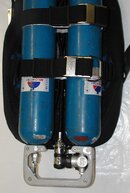DaleC
Contributor
I'm not clear on what you're saying - is it that one has to redesign the valve system to dive inverted? If so, someone should tell Akimbo.
The idea of HP tanks is interesting and I bet a lot of people would like to be able to use smaller tanks of the same volume but my limited experience has been that getting HP fills is problematic even now with 3400psi tanks. Pumping those higher psi's seems to create more wear and tear on the compressor and getting a somewhat accurate hot fill means going up into the high 3000's. I could imagine 4500 rated tanks for scuba would come with a whole bunch of increased cost to compensate compressor wear and with increased hydro/vis requirements imposed by nervous filler operators.
What would completely solve the problem would be for a certain cave diver to begin adopting the system, along with his affiliated company making the cage. Then, everybody would want one and it would become the new "right way" to dive.
Laugh if you want but you know it's true... can anyone say "infinity"
The idea of HP tanks is interesting and I bet a lot of people would like to be able to use smaller tanks of the same volume but my limited experience has been that getting HP fills is problematic even now with 3400psi tanks. Pumping those higher psi's seems to create more wear and tear on the compressor and getting a somewhat accurate hot fill means going up into the high 3000's. I could imagine 4500 rated tanks for scuba would come with a whole bunch of increased cost to compensate compressor wear and with increased hydro/vis requirements imposed by nervous filler operators.
What would completely solve the problem would be for a certain cave diver to begin adopting the system, along with his affiliated company making the cage. Then, everybody would want one and it would become the new "right way" to dive.
Laugh if you want but you know it's true... can anyone say "infinity"




